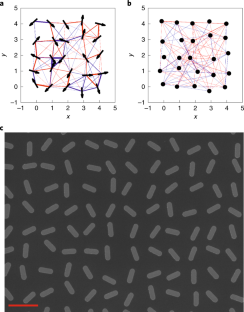「スピングラス」を記述する理論モデルは、脳機能や株式市場のダイナミクスなど、他の複雑なシステムにも広く用いられている Theoretical models describing ‘spin glasses’ are broadly used in other complex systems, including brain function and stock-market dynamics
2022-03-24 ロスアラモス国立研究所(LANL)
<関連情報>
- https://discover.lanl.gov/news/0324-printing-circuits
- https://www.nature.com/articles/s41567-022-01538-7
ナノ磁性人工ホップフィールドネットワークにおける動的ガラス転移の直接観察 Direct observation of a dynamical glass transition in a nanomagnetic artificial Hopfield network
Michael Saccone,Francesco Caravelli,Kevin Hofhuis,Sergii Parchenko,Yorick A. Birkhölzer,Scott Dhuey,Armin Kleibert,Sebastiaan van Dijken,Cristiano Nisoli &Alan Farhan
Nature Physics Published: 17 March 2022 https://doi.org/10.1038/s41567-022-01538-7

Abstract
Spin glasses, generally defined as disordered systems with randomized competing interactions1,2, are a widely investigated complex system. Theoretical models describing spin glasses are broadly used in other complex systems, such as those describing brain function3,4, error-correcting codes5 or stock-market dynamics6. This wide interest in spin glasses provides strong motivation to generate an artificial spin glass within the framework of artificial spin ice systems7,8,9. Here we present the experimental realization of an artificial spin glass consisting of dipolar coupled single-domain Ising-type nanomagnets arranged onto an interaction network that replicates the aspects of a Hopfield neural network10. Using cryogenic X-ray photoemission electron microscopy (XPEEM), we performed temperature-dependent imaging of thermally driven moment fluctuations within these networks and observed characteristic features of a two-dimensional Ising spin glass. Specifically, the temperature dependence of the spin glass correlation function follows a power-law trend predicted from theoretical models on two-dimensional spin glasses11. Furthermore, we observe clear signatures of the hard-to-observe rugged spin glass free energy1 in the form of sub-aging, out-of-equilibrium autocorrelations12 and a transition from stable to unstable dynamics1,13.



・スピングラスにより、脳と同じように部分的な画像からオブジェクトを認識し、特に低電力コンピューティングのAIの形式が可能になる。
・ロスアラモス国立研究所のマイケル・サッコーネ氏は「我々の研究は、神経ネットワークを再現するように配置されたナノ磁石からなる人工スピングラスを初めて実験で実現した」と語っている。